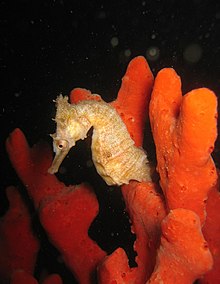Hi Guys!
Now, I'm going to tell you a lot of informations about an animal called seahorse.
I believe that you guys know this animal.
Okay, let's start.
Seahorse is the name given to small marine fishes in the genus Hippocampus. "Hippocampus" comes from the Ancient Greek word hippos meaning "horse" and kampos meaning "sea monster". The word "seahorse" can also be written as two separate words (sea horse), or hyphenated (sea-horse).
Having a head and neck like a horse, seahorses also feature segmented bony armour, an upright posture and a curled prehensile tail.
The Scientific Classification of seahorse:
Kingdom : Animalia
Phylum : Chordata
Class : Actinopterygii
Order : Syngnathiformes
Family : Syngnathidae
Subfamily : Hippocampinae
Genus : Hippocampus
In 2012, there are 54 species of seahorse. Some of them are:
.jpg) |
| Hippocampus hippocampus Linnaeus, 1758 (short-snouted seahorse) |
 |
| Hippocampus subelongatus Castelnau, 1873 (West Australian seahorse) |
 |
| Hippocampus whitei Bleeker, 1855 (White's seahorse) |
Pygmy Seahorses
|
Seahorses range in size from 1.5 to 35.5 cm. They are named for their equine appearance with bent necks and long snouted heads followed by their distinctive trunk and tail. Although they are bony fish, they do not have scales, but rather thin skin stretched over a series of bony plates, which are arranged in rings throughout their bodies. Each species has a distinct number of rings. Seahorses swim upright using their dorsal fin. The pectoral fins located on their side of the head are used for maneuvering. Their prehensile tail can only be used in the most extreme conditions. They are adept at camouflage depending on their habitat.
Unusual among fish, a seahorse has a flexible, well-defined neck. It also sports a crown-like spine or horn on its head, termed a "coronet," which is distinct for each species.
Seahorses swim very poorly, rapidly fluttering a dorsal fin and using pectoral fins. The slowest-moving fish in the world is H. zosteare (the dwarf seahorse). Since they are poor swimmers, they usually found resting with their prehensile tails wound around an object. They have long snouts, which they use to suck up food, and their eyes can move independently of each other.
Seahorses are mainly found in shallow tropical and temperate waters throughout the world, from about 45°S to 45°N and live in sheltered areas such as seagrass, estuaries, coral reefs, or mangroves.
Seahorses feed on small crustaceans floating in the water or crawling on the bottom. With excellent camouflage and patience, seahorses attack prey that floats. Mysid shrimp and other small crustaceans are favorites, but some seahorses have been observed eating other kinds of invertebrates and even larval fish.
SEAHORSE AS PETS
Many aquarium hobbyists keep them as pets. Seahorses should be kept in an aquarium with low flow and placid tank mates. Keepers should look carefully at good water quality. A water quality problems will affect to seahorse, such as reduced feeding, erratic swimming, and gasping at the surface. Seahorses swim up and down, using the length of the aquarium. Therefore, the tanks should ideally be twice as deep as the length of the adult seahorse.
They are slow feeders, so, fast and aggressive feeders will leave them without food. Seahorses can live with many species of shrimp and other bottom-feeding creatures. Keepers have to avoid eels, tangs, triggerfish, squid, octopus, and sea anemons.
SEAHORSE AS DELICACY AND CHINESE MEDICINE
The consumption of seahorses is widespread in traditional Chinese medicine, primarily in connection with impotence, wheezing, nocturnal enuresis, and pain, as well as labor induction. Up to 20 million seahorses may be caught each year to be sold for such uses. Seahorses are also consumed by the Indonesians, the central Filipinos, and many other ethnic groups.
That's all some informations about seahorse. Hope this blog can expand your knowledge.
Thankyou for reading:)


Tidak ada komentar:
Posting Komentar